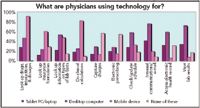Article
Doctors are getting more tech savvy
While EHRs remain uncommon, physicians are taking advantage of many new devices and media, our survey shows.

Key Points

To find out how physicians are using information technology, Medical Economics recently did a survey with Epocrates, which supplies electronic drug information, decision support tools, and CME to about 200,000 physicians. Nearly all of the 503 respondents are Epocrates users, so they're more technology-oriented than the average physician. In addition, the majority of respondents are male primary care physicians, and doctors in groups of 10 or more physicians are disproportionately represented. More respondents practice in the Northeast, the Southeast, or the Midwest than in the Southwest or the West.
Despite these biases, however, the survey results appear to reflect many characteristics of technology-using physicians. Here's what we found, and what some experts and physicians think it means.
Most respondents use PDAs in their clinical work-no surprise, since 91 percent of these Epocrates subscribers look up drugs, dosages, and interactions on their PDAs. An unexpected finding is that 31 percent of the respondents use smartphones (PDAs combined with cell phones). The increasing capabilities of such devices and the convenience of carrying one gadget that performs these functions, instead of two, account for the growth in this area, say experts.
Salvatore S. Volpe, a med-peds specialist in Staten Island, NY, who plans to get a smartphone, notes that the latest models are very fast, are reasonably priced, send and receive e-mail via cellular networks, and can run programs such as Microsoft Word and Excel.

"There's no reason for anyone to send me CDs or DVDs anymore," says FP Louis E. Spikol of Allentown, PA, who works part time for the American Academy of Family Physicians. "Eventually, they should just make it into a podcast that you can download."
Today, however, doctors are using old and new technologies side by side. For example, 62 percent of respondents obtain medical information on CDs or DVDs, and the CD/DVD category ranks first for CME. Meanwhile, the popularity of live and archived webcasts-a relatively new technology-is on the rise. Around 30 percent and 40 percent of respondents, respectively, employ these media for both medical information and CME, and roughly 60 percent believe they'll be using them five years from now.
Webcasts increasingly include streaming video, which is played as it arrives on your computer. Streaming video offers some new ways to learn. For instance, FP Timothy W. Allen of Cudahy, WI, says he took a stroke certification course using a streaming video that featured simulated patients.
CME courses for PDAs are only a couple of years old. Nevertheless, 48 percent of respondents are using PDAs for CME, and 67 percent expect to be doing so five years from now.





